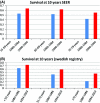Modern treatment in chronic lymphocytic leukemia: impact on survival and efficacy in high-risk subgroups
- PMID: 24648042
- PMCID: PMC4101746
- DOI: 10.1002/cam4.226
Modern treatment in chronic lymphocytic leukemia: impact on survival and efficacy in high-risk subgroups
Abstract
Treatment of chronic lymphocytic leukemia (CLL) has dramatically changed over the last years, with significant improvement in overall survival (OS) and increased efficacy in genetically defined "high-risk" disease. Besides prospective clinical trials usually enrolling young and fit patients, retrospective studies were performed comparing the outcome of patients belonging to different age groups and showing longer survival in patients diagnosed in the most recent periods. In patients younger than 70 years the 10-year relative survival was 43-53% in the 1980s as compared with 59-63% in the 2000s. Likewise, the 10-year relative survival in patients >70 years was 22-42% in the 1980s and 46-55% in the 2000s. Improved outcome derived in part by the introduction of effective regimens in genetically defined "high-risk" disease (i.e., 17p-, 11q-, TP53, NOTCH1, SF3B1 mutations), especially in the younger and/or fit patients. The unfavorable prognostic significance of 11q- was overcome by chemoimmunotherapy. High-dose steroids with anti-CD52 appeared to improve the response rate in 17p-/TP53 mutated cases and allogeneic transplantation achieved prolonged disease control irrespective of high-risk disease. Further improvement is being generated by the new anti-CD20 obinutuzumab in the elderly and by mechanism-based treatment using kinase-targeting agents or anti-BCL2 molecules yielding high-response rate and impressive progression-free survival in the chemorefractory setting as well as in previously untreated patients.
Keywords: BCL2; Chronic lymphocytic leukemia; chemoimmunotherapy; genetic lesions; tyrosine-targeted treatment.
© 2014 The Authors. Cancer Medicine published by John Wiley & Sons Ltd.
Figures

References
-
- Hillmen P. Using the biology of chronic lymphocytic leukemia to choose treatment. Hematol. Am. Soc. Hematol. Educ. Prog. 2011;2011:104–109. - PubMed
-
- Chiorazzi N. Development and evolution of chronic lymphocytic leukemia. Hematol. Educ. 2012;6:73–92.
-
- Ciccone M, Agostinelli C, Rigolin GM, Piccaluga PP, Cavazzini F, Righi S, et al. Proliferation centers in chronic lymphocytic leukemia: correlation with cytogenetic and clinicobiological features in consecutive patients analyzed on tissue microarrays. Leukemia. 2012;26:499–508. - PubMed
Publication types
MeSH terms
Substances
LinkOut - more resources
Full Text Sources
Other Literature Sources
Research Materials
Miscellaneous

